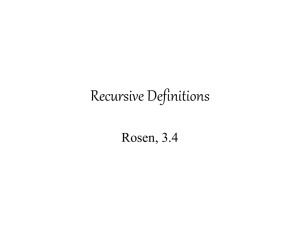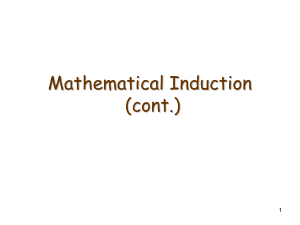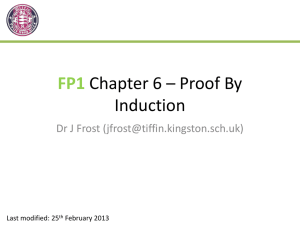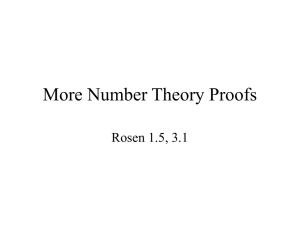slides
advertisement
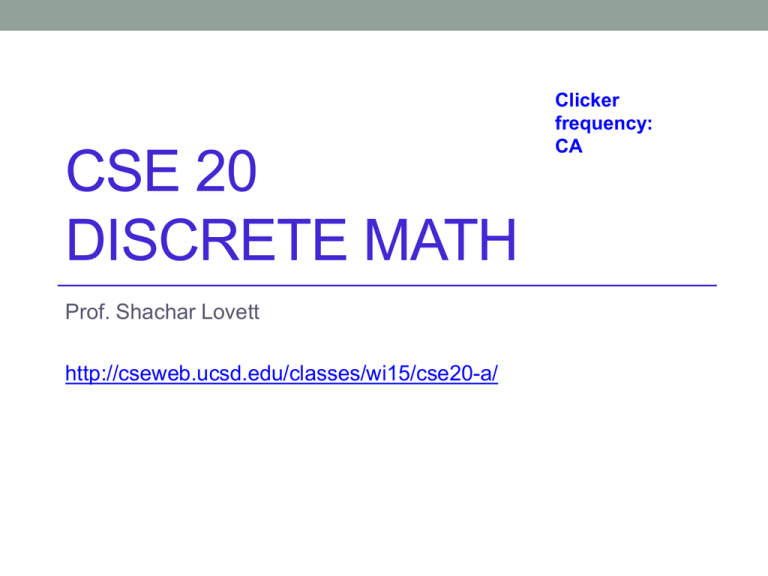
CSE 20 DISCRETE MATH Prof. Shachar Lovett http://cseweb.ucsd.edu/classes/wi15/cse20-a/ Clicker frequency: CA Todays topics • Strong induction • Section 3.6.1 in Jenkyns, Stephenson Strong vs regular induction • Goal is the same: prove ∀𝑛 ≥ 1, 𝑃(𝑛) • Standard induction: • Base case: n=1 • From one step to the next: ∀𝑛 ≥ 1, 𝑃 𝑛 → 𝑃(𝑛 + 1) • Strong induction: • Base case: n=1 • Assume more in each step: ∀𝑛 ≥ 1, 𝑃 1 ∧ ⋯ ∧ 𝑃 𝑛 → 𝑃(𝑛 + 1) Strong vs regular induction • Goal is the same: prove ∀𝑛 ≥ 1, 𝑃(𝑛) • Standard induction: • Base case: n=1 • From one step to the next: ∀𝑛 ≥ 1, 𝑃 𝑛 → 𝑃(𝑛 + 1) P(1) P(2) P(3) … P(n) P(n+1) … • Strong induction: • Base case: n=1 • Assume more in each step: ∀𝑛 ≥ 1, 𝑃 1 ∧ ⋯ ∧ 𝑃 𝑛 P(1) P(2) P(3) … P(n) → 𝑃(𝑛 + 1) P(n+1) … 5 Example for the power of strong induction • Theorem: For all prices p >= 8 cents, the price p can be paid using only 5-cent and 3-cent coins • Proof: • Base cases: 8=3+5, 9=3+3+3, 10=5+5 • Assume it holds for all prices 8...p-1, prove for price p when 𝑝 ≥ 11 • Proof: since 𝑝 − 3 ≥ 8 we can use the inductive hypothesis for p-3. To get price p simply add another 3-cent coin. • Much easier than standard induction! Another example: divisibility • Thm: For all integers n>1, n is divisible by a prime number. • Before proving it (using strong induction), lets first review some of the basic definitions, but now make them precise Definitions and properties for this proof • Definitions: • n is prime if ∀𝑎, 𝑏 ∈ 𝑁, 𝑛 = 𝑎𝑏 → (𝑎 = 1 ∨ 𝑏 = 1) • n is composite if n=ab for some 1<a,b<n • Prime or Composite exclusivity: • All integers greater than 1 are either prime or composite (exclusive or—can’t be both). • Definition of divisible: • n is divisible by d iff n = dk for some integer k. • 2 is prime (you may assume this; it also follows from the definition). Definitions and properties for this proof (cont.) • Goes without saying at this point: • The set of Integers is closed under addition and multiplication • Use algebra as needed Thm: For all integers n>1, n is divisible by a prime number. Proof (by strong mathematical induction): Basis step: Show the theorem holds for n = ________. Inductive step: Assume [or “Suppose”] that WTS that So the inductive step holds, completing the proof. Thm: For all integers n>1, n is divisible by a prime number. Proof (by strong mathematical induction): Basis step: Show the theorem holds for n = ________. Inductive step: Assume [or “Suppose”] that WTS that A. B. C. D. E. So the inductive step holds, completing the proof. 0 1 2 3 Other/none/more than one Thm: For all integers n>1, n is divisible by a prime number. Proof (by strong mathematical induction): Basis step: Show the theorem holds for n = _2______. Inductive step: Assume [or “Suppose”] that WTS that A. For some integer n>1, n is divisible by a prime number. B. For some integer n>1, k is divisible by a prime number, for all integers k where 2kn. C. Other/none/more than one So the inductive step holds, completing the proof. Thm: For all integers n>1, n is divisible by a prime number. Proof (by strong mathematical induction): Basis step: Show the theorem holds for n = _2______. Inductive step: Assume [or “Suppose”] that for some integer n>1, k is divisible by a prime number for all integers k where 𝟐 ≤ 𝒌 ≤ 𝒏 WTS that A. n+1 is divisible by a prime number. B. k+1 is divisible by a prime number. C. Other/none/more than one So the inductive step holds, completing the proof. 13 Thm: For all integers n>1, n is divisible by a prime number. Proof (by strong mathematical induction): Basis step: Show the theorem holds for n=2. Inductive step: Assume that for some n2, all integers 2kn are divisible by a prime. WTS that n+1 is divisible by a prime. Proof by cases: • Case 1: n+1 is prime. n+1 divides itself so we are done. • Case 2: n+1 is composite. Then n+1=ab with 1<a,b<n+1. By the induction hypothesis, since an there exists a prime p which divides a. So p|a and a|n+1. We’ve already seen that this Implies that p|n+1 (in exam – give full details!) So the inductive step holds, completing the proof. Theorems about recursive definitions • Consider the following sequence: • d1=9/10 • d2=10/11 • dn=dn-1 * dn-2 ∀𝑛 ≥ 3 • Theorem: ∀𝑛 ≥ 1, 0 < 𝑑𝑛 < 1 • Facts the we will need for the proof: • If 0<x,y<1 then 0<xy<1 • Algebra, etc Definition of the sequence: d1 = 9/10 d2 = 10/11 dk = (dk-1)(dk-2) for all integers k3 Thm: For all integers n>0, 0<dn<1. Proof (by strong mathematical induction): Basis step: Show the theorem holds for n = ________. Inductive step: Assume [or “Suppose”] that WTS that So the inductive step holds, completing the proof. Definition of the sequence: d1 = 9/10 d2 = 10/11 dk = (dk-1)(dk-2) for all integers k3 Thm: For all integers n>0, 0<dn<1. Proof (by strong mathematical induction): Basis step: Show the theorem holds for n = ________. A. 0 Inductive step: Assume [or “Suppose”] that WTS that So the inductive step holds, completing the proof. B. C. D. E. 1 2 3 Other/none/more than one Definition of the sequence: d1 = 9/10 d2 = 10/11 dk = (dk-1)(dk-2) for all integers k3 Thm: For all integers n>0, 0<dn<1. Proof (by strong mathematical induction): Basis step: Show the theorem holds for n = _1,2_____. Inductive step: Assume [or “Suppose”] that WTS that A. For some int n>0, 0<dn<1. B. For some int n>1, 0<dk<1, for all integers k where 1kn. C. Other/none/more than one So the inductive step holds, completing the proof. Definition of the sequence: d1 = 9/10 d2 = 10/11 dk = (dk-1)(dk-2) for all integers k3 Thm: For all integers n>0, 0<dn<1. Proof (by strong mathematical induction): Basis step: Show the theorem holds for n = _1,2_____. Inductive step: Assume [or “Suppose”] that WTS that A. For some int n>0, 0<dn<1. B. For some int n>1, 0<dk<1, for all integers k where 1kn. C. 0<dn+1<1 D. Other/none/more than one So the inductive step holds, completing the proof. Definition of the sequence: d1 = 9/10 d2 = 10/11 dk = (dk-1)(dk-2) for all integers k3 Thm: For all integers n>0, 0<dn<1. Proof (by strong mathematical induction): Basis step: Show the theorem holds for n=1,2. Inductive step: Assume [or “Suppose”] that the theorem holds for n2. WTS that 0<dn+1<1. By definition, dn+1=dn dn-1. By the inductive hypothesis, 0<dn-1<1 and 0<dn<1. Hence, 0<dn+1<1. So the inductive step holds, completing the proof. Fibonacci numbers • 1,1,2,3,5,8,13,21,… • Rule: F1=1, F2=1, Fn=Fn-2+Fn-1. • Question: can we derive an expression for the n-th term? Fibonacci numbers • 1,1,2,3,5,8,13,21,… • Rule: F1=1, F2=1, Fn=Fn-2+Fn-1. • Question: can we derive an expression for the n-th term? • YES! 1 1+ 5 𝐹𝑛 = 2 5 𝑛 1 1− 5 − 2 5 𝑛 22 Fibonacci numbers • Rule: F1=1, F2=1, Fn=Fn-2+Fn-1. • We will prove an upper bound: 𝐹𝑛 ≤ 𝑟𝑛, • Proof by strong induction. 1+ 5 𝑟= 2 23 Fibonacci numbers • Rule: F1=1, F2=1, Fn=Fn-2+Fn-1. • We will prove an upper bound: 𝐹𝑛 ≤ 1+ 5 𝑟= 2 𝑟𝑛, • Proof by strong induction. • Base case: A. B. C. D. E. n=1 n=2 n=1 and n=2 n=1 and n=2 and n=3 Other 24 Fibonacci numbers • Rule: F1=1, F2=1, Fn=Fn-2+Fn-1. • We will prove an upper bound: 𝐹𝑛 ≤ 1+ 5 𝑟= 2 𝑟𝑛, • Proof by strong induction. • Base case: A. B. C. D. E. n=1 n=2 n=1 and n=2 n=1 and n=2 and n=3 Other 25 Fibonacci numbers • Rule: F1=1, F2=1, Fn=Fn-2+Fn-1. • We will prove an upper bound: 𝐹𝑛 ≤ 𝑟𝑛, 1+ 5 𝑟= 2 • Proof by strong induction. • Base case: n=1,2 • Verify by direct calculation: 𝐹1 = 1 ≤ 𝑟, 𝐹2 = 1 ≤ 𝑟 2 26 Fibonacci numbers • Rule: F1=1, F2=1, Fn=Fn-2+Fn-1. • We will prove an upper bound: 𝐹𝑛 ≤ 𝑟𝑛, 1+ 5 𝑟= 2 • Proof by strong induction. • Base case: n=1,2 • Inductive case: show… A. B. C. D. E. Fn=Fn-1+Fn-2 FnFn-1+Fn-2 Fn=rn Fn rn Other Proof of inductive case • WTS: 𝐹𝑛 ≤ 𝑟 𝑛 • What can we use? • Definition: 𝐹𝑛 = 𝐹𝑛−1 + 𝐹𝑛−2 • Inductive assumption: 𝐹𝑘 ≤ 𝑟 𝑘 ∀𝑘 < 𝑛 • So, we know that 𝐹𝑛 ≤ 𝑟 𝑛−1 + 𝑟 𝑛−2 • Need to show that 𝑟 𝑛−1 + 𝑟 𝑛−2 ≤ 𝑟 𝑛 Proof of inductive case (contd) • Need to show that 𝑟 𝑛−1 + 𝑟 𝑛−2 ≤ 𝑟 𝑛 • Equivalently: r + 1 ≤ 𝑟 2 • It turns out that this is satisfied by our choice of 𝑟 = • In fact, it is a root of the quadratic 𝑥 2 − 𝑥 − 1 = 0 (so in fact r + 1 = 𝑟 2 ) • The other root is 1− 5 2 1 ; recall the formula 1+ 5 𝐹𝑛 = 2 5 • 𝑛 1 1− 5 − 2 5 𝑛 1+ 5 2 29 Fibonacci numbers - recap • Recursive definition of a sequence • Base case: verify for n=1, n=2 • Inductive step: • Formulated what needed to be shown as an algebraic inequality, using the definition of Fn and the inductive hypothesis • Simplified algebraic inequality • Proved the simplified version Next class • Applying proof techniques to analyze algorithms • Read section 3.7 in Jenkyns, Stephenson
